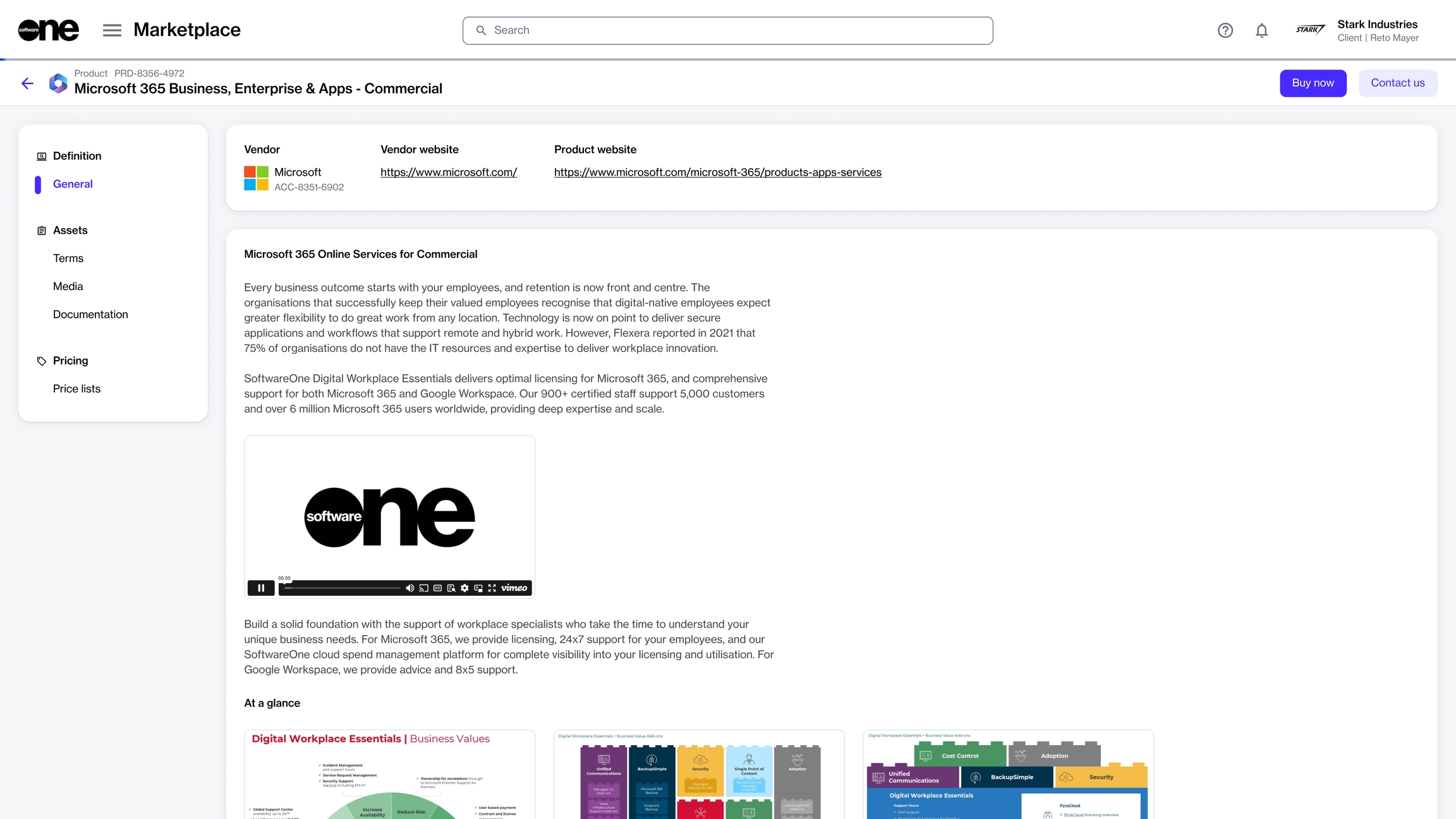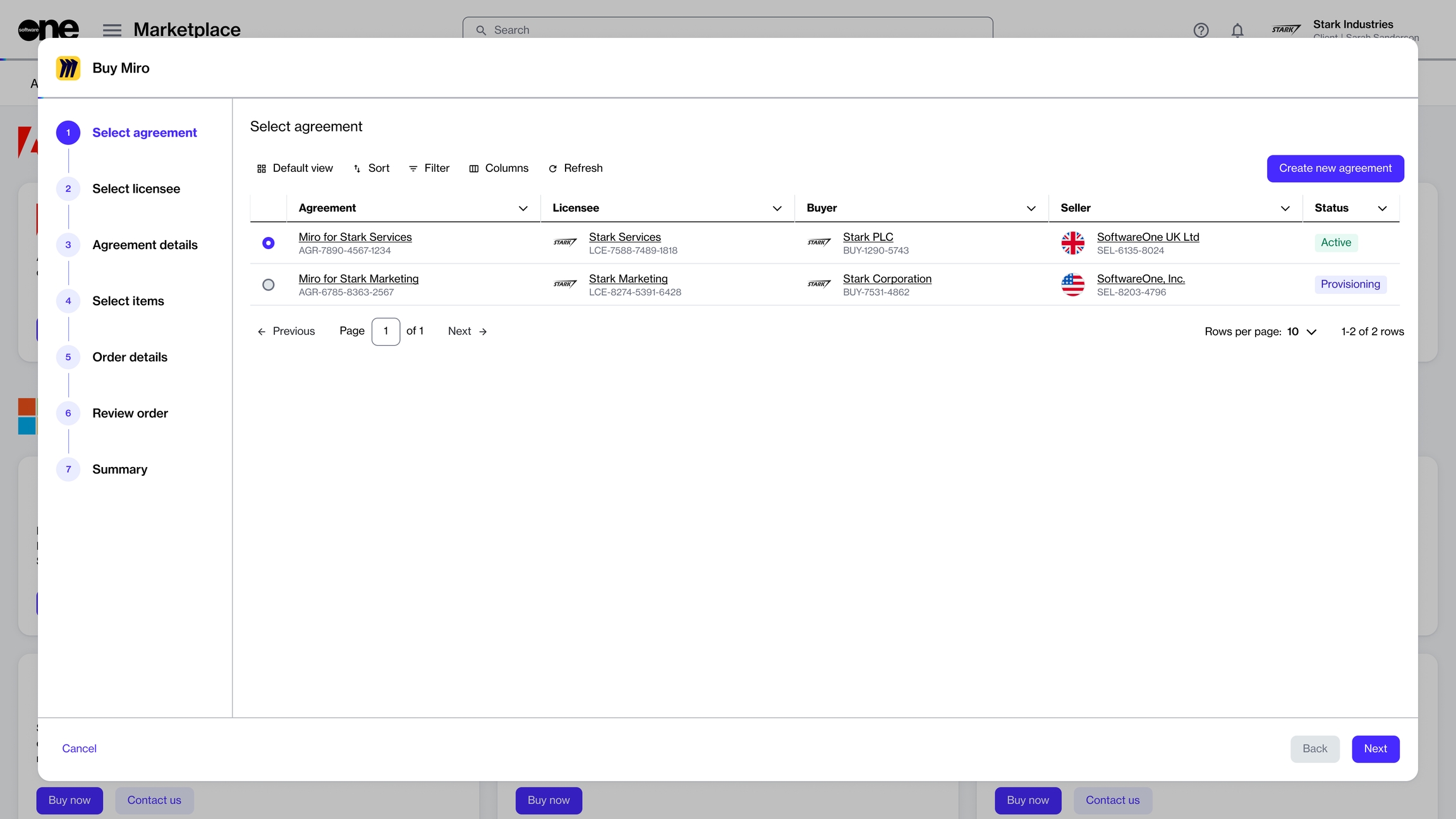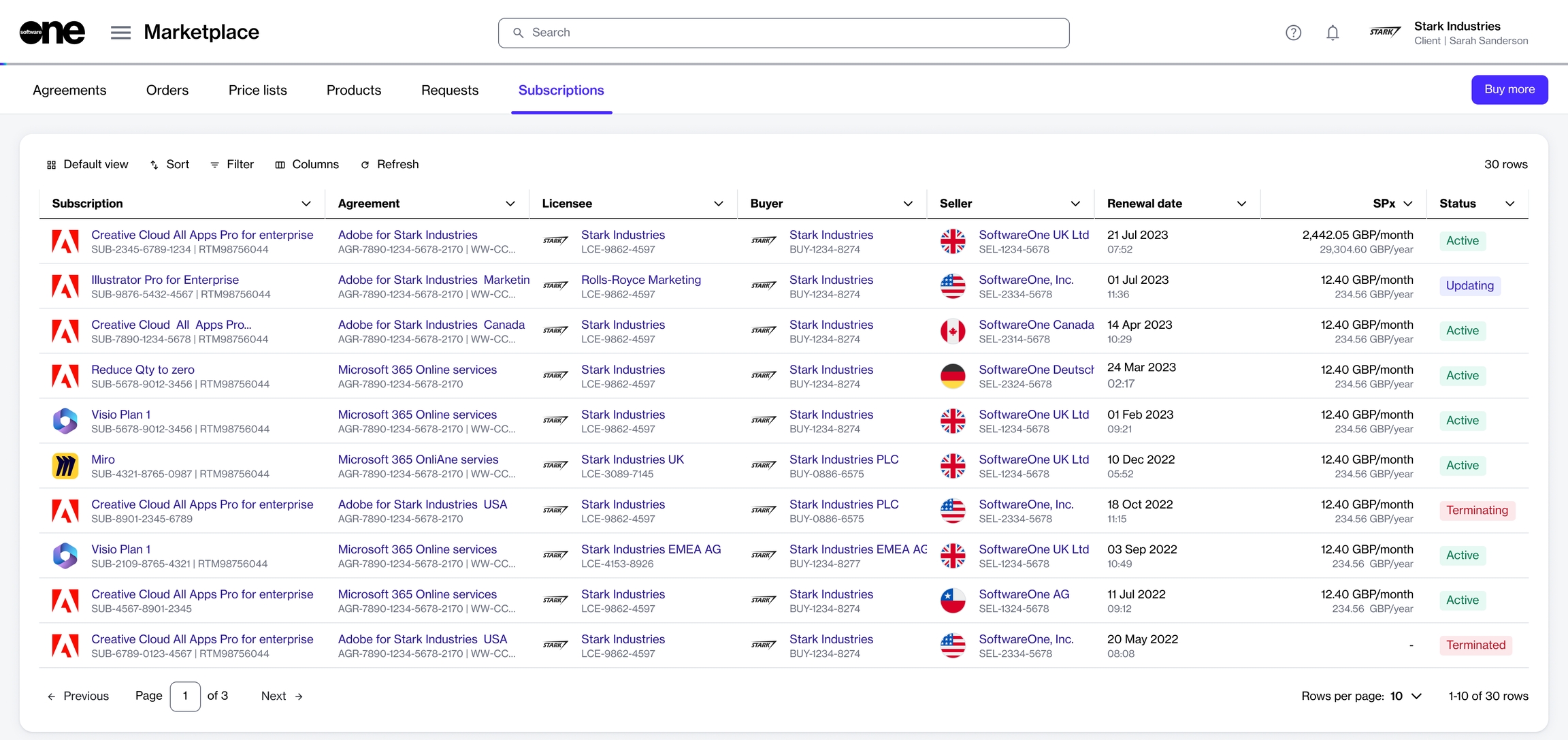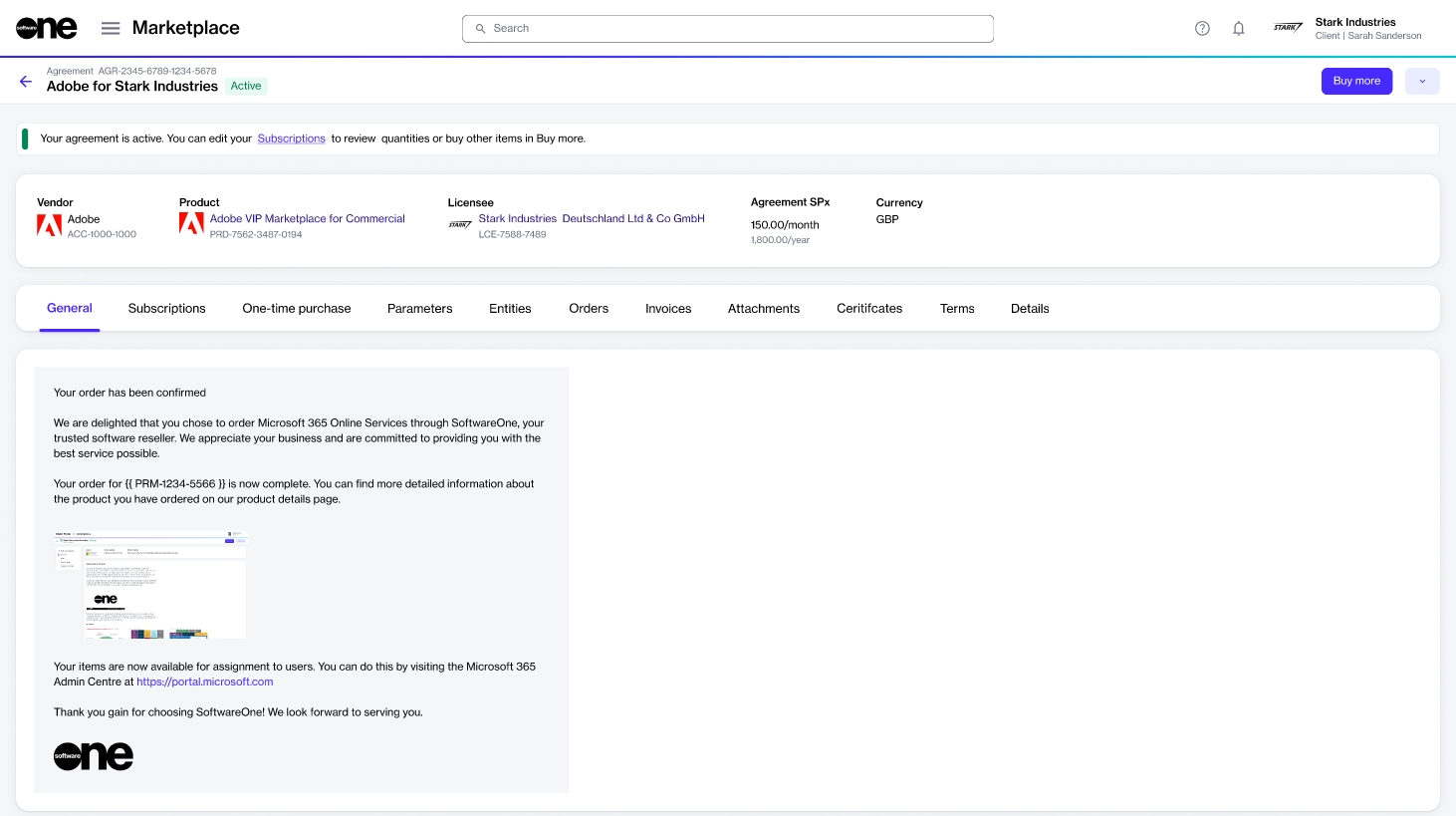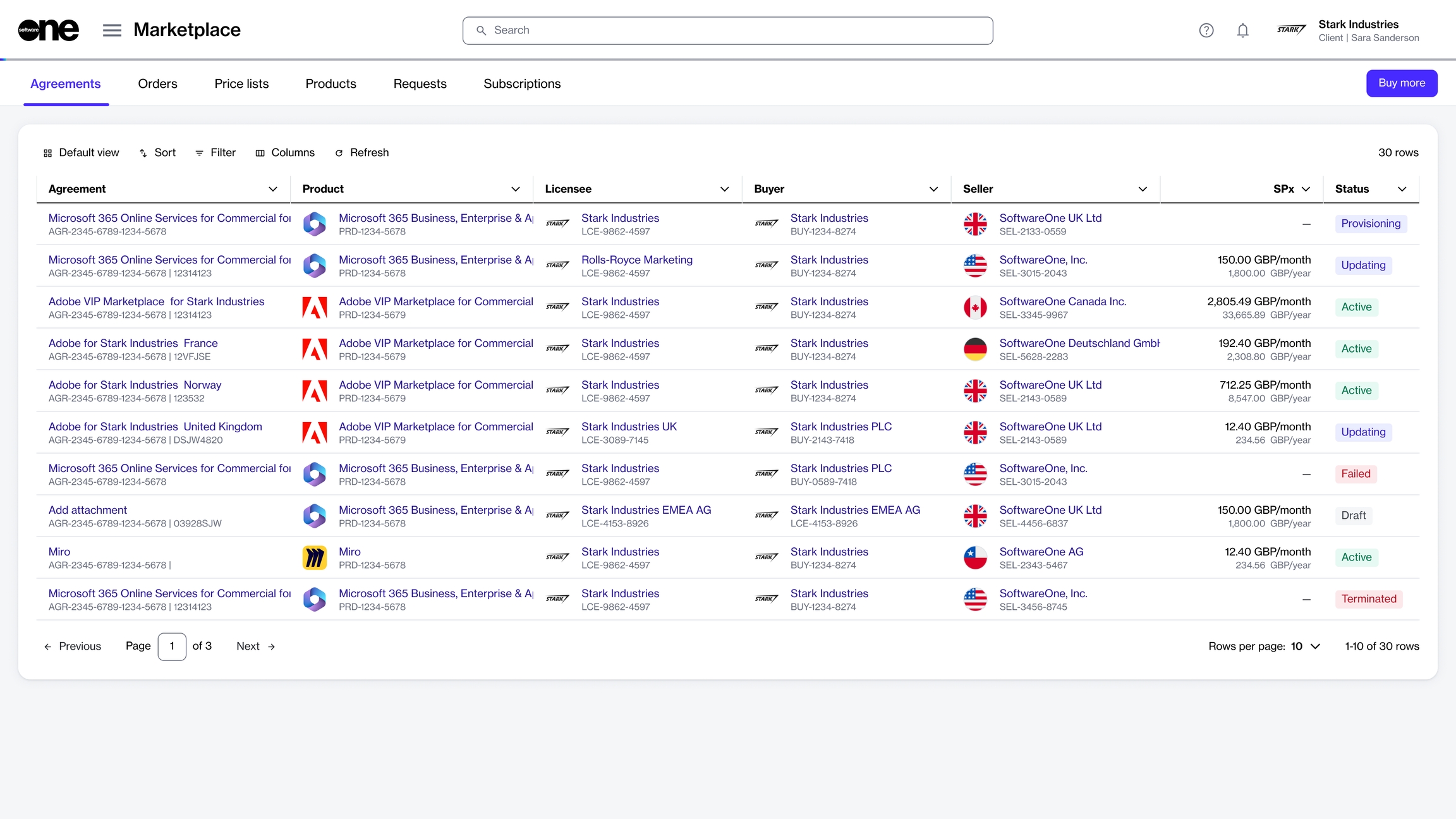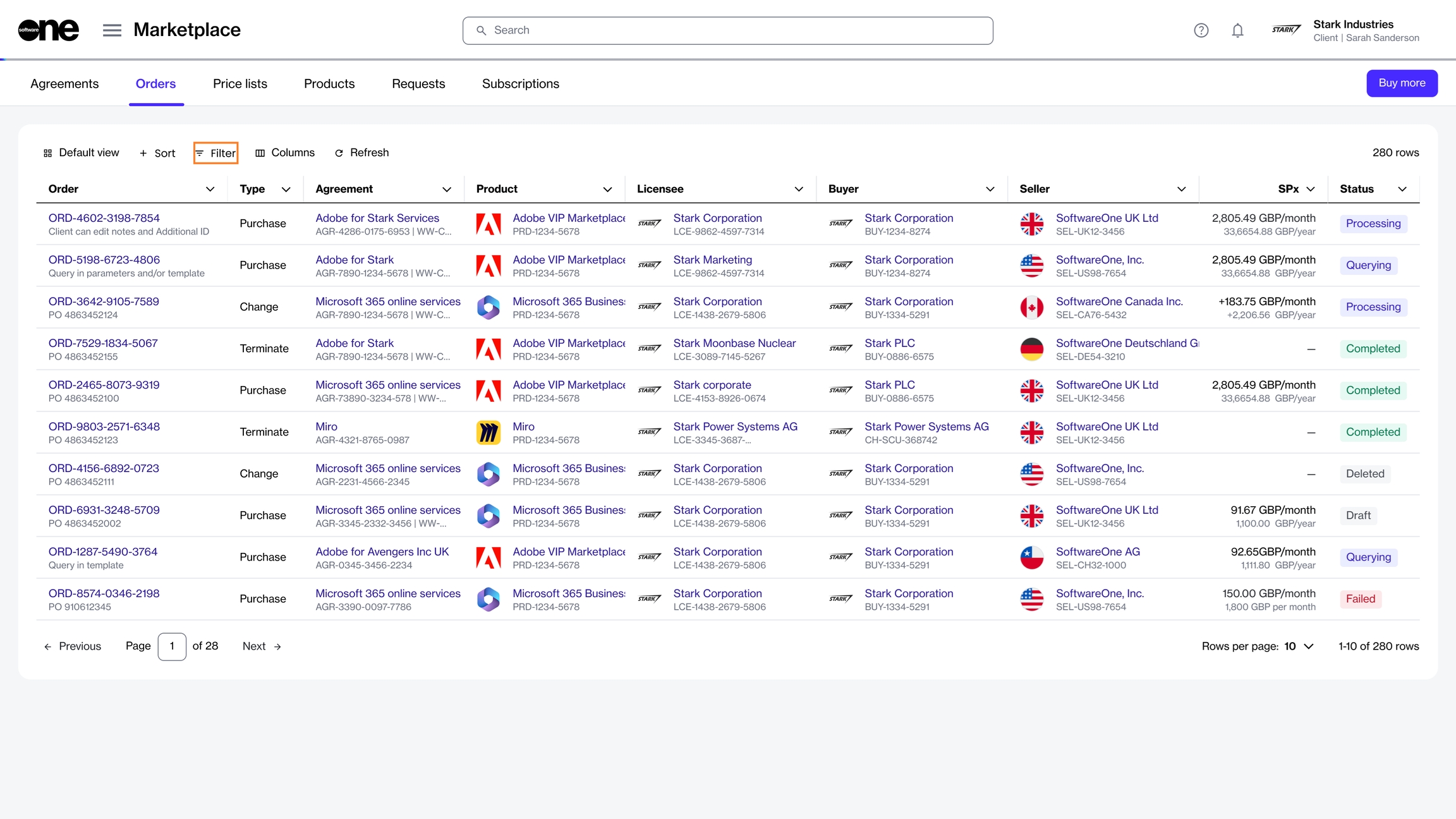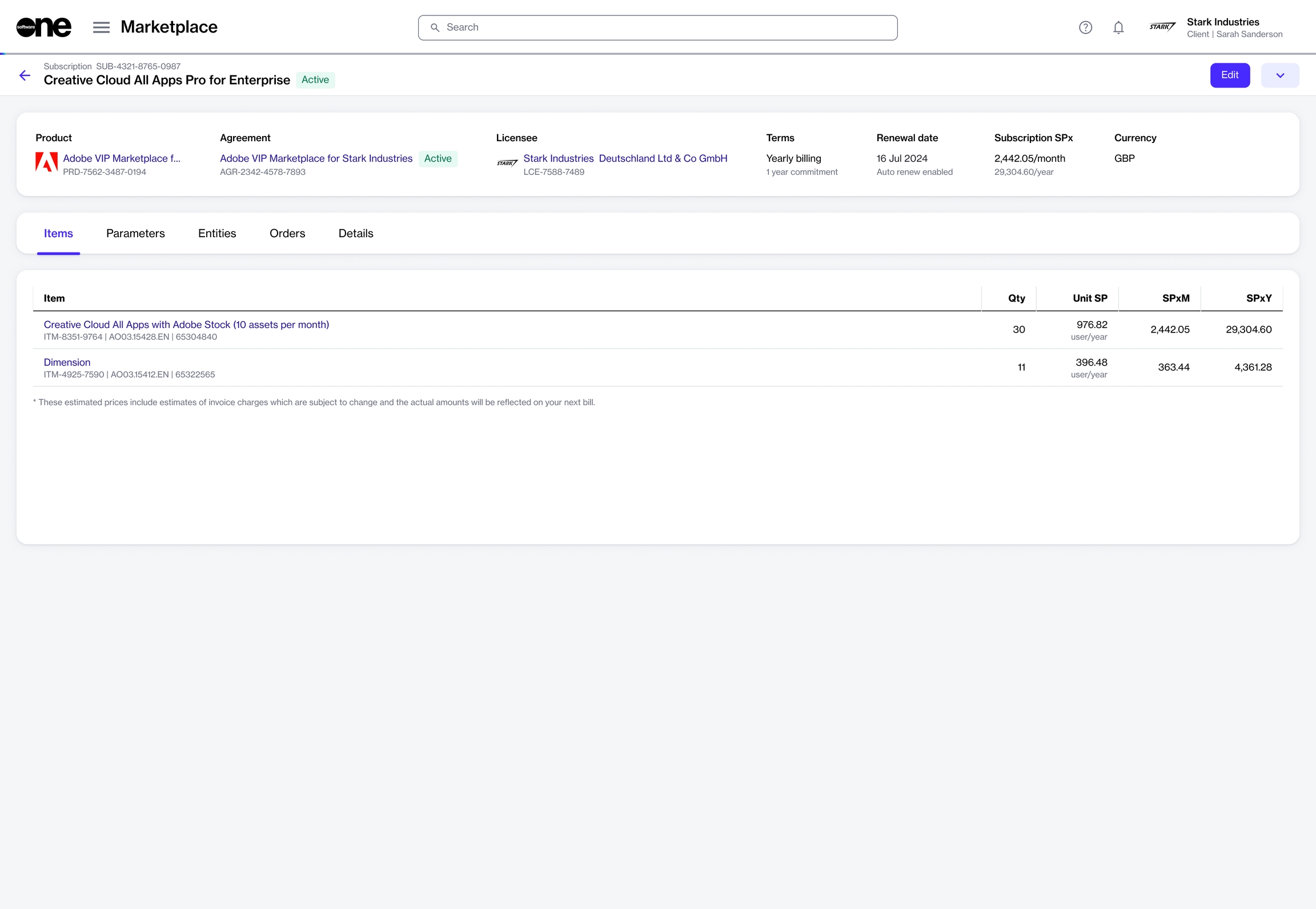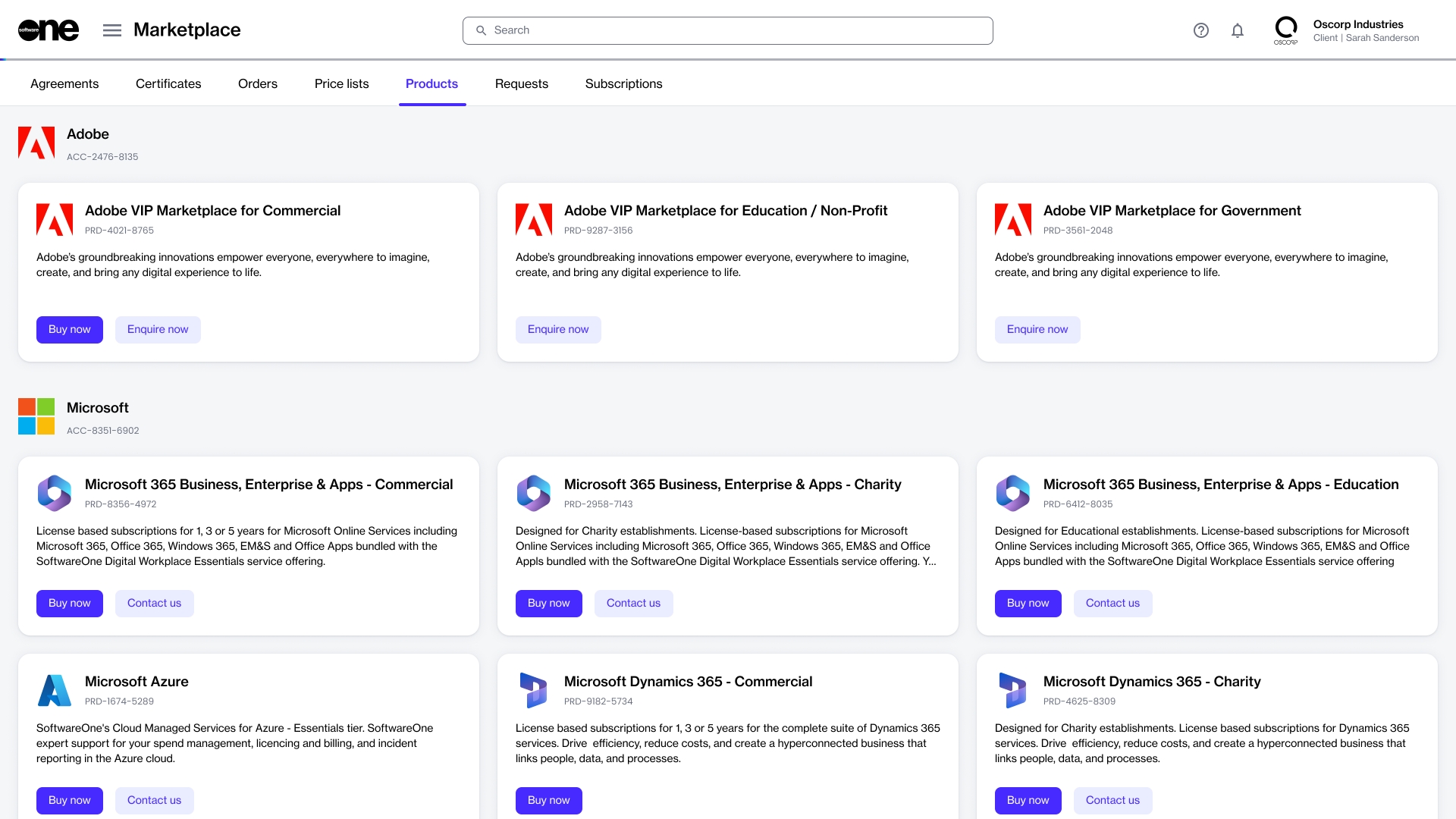
Loading...
Loading...
Loading...
Loading...
Loading...
Loading...
Loading...
Loading...
Loading...
The Marketplace Platform is a centralized hub designed to streamline the discovery and ordering of subscription-based software products.
The platform simplifies the complex process of software licensing and procurement, making it easier for you to find and compare products from multiple software vendors in one place. Each product on our marketplace undergoes a process, where vendors define the product including its terms of use, and submit it to SoftwareOne. Products become available for ordering only after they have been accepted by SoftwareOne.
You can access the SoftwareOne Marketplace by signing in to your account and selecting Marketplace > Products from the main menu.
The Products page shows all the products that are available for you to order. The page displays products by the vendor name and a brief product description.
To view detailed information about a product, click the product name.
You'll then see detailed product information, including the product's terms and conditions, pricing information, and more. See Products Interface for more information.
Once you've reviewed the product details and selected the product you want to buy, you can start the ordering process by clicking Buy now.
When you click the button, the Purchase Wizard opens. The wizard is designed to help you create a purchase order by guiding you through all the necessary steps.
Note that the steps will vary depending on the product you are ordering and the product vendor. At a high level, you'll need to complete the following steps:
Select an agreement - Select whether you want to use an existing agreement or create a new one. The option you select in this step determines the next step in the wizard.
If you are creating a new agreement, the Select licensee section opens.
If you are using an existing agreement, the Select items section opens.
Select a licensee - Choose a licensee from the list of your licensees or create a new one.
Provide agreement details - Fill out the contact form.
Select items - Choose the items you want to order and the quantity of those items.
Add reference details - Add the optional order and agreement details.
Review order - Preview the order details and then click Place order to finalize.
Review summary - See your order summary and the latest status message.
For products, like Adobe and Microsoft, you'll need to complete additional steps when you're placing the order. For step-by-step guidance on these products, see Adobe Tutorials and Microsoft Tutorials.
Subscription management through self-service is one of the key features of our platform, providing you with the flexibility to manage your subscriptions.
it means you can easily order new subscriptions, increase or decrease your licenses, and cancel subscriptions. You also have the option to edit the name of your subscription and modify subscription IDs, if needed.
You can view your subscriptions by selecting the main menu of the Client Portal and then choosing Marketplace > Subscriptions.
The page displays the important information regarding your subscriptions. To view the details of an individual subscription, click the subscription name. For more information, see Subscriptions Interface.
If you want to change the quantity of items in your subscription, you can do this by placing a change order. You can edit the subscription to make these changes.
For instance, if you need more licenses, you can update the quantity of licenses in the subscription. The same process applies if you want to lower your licenses.
For detailed instructions, see How to change license quantity.
If you want to add a new item to your subscription, you can edit the agreement. It means if you want to purchase new items, you don't need to create a new agreement. You can simply edit your agreement to include the new items.
This can be done through the Buy more option on the agreement's details page. For detailed instructions, see How to add new items to your agreement.
If you want to cancel a single subscription or all subscriptions in an agreement, you'll need to place a termination order. Without a termination order, subscriptions cannot be cancelled.
You can cancel a single subscription using the Terminate option on the details page of the subscription. However, to cancel all subscriptions in your agreement, you must terminate the entire agreement.
To learn more about canceling a single subscription, see Terminate subscriptions. To cancel all subscriptions in your agreement, see Terminate Agreements.
The Agreements page is where you can access all your agreements in one place.
As agreements contain subscriptions, having access to your agreements in one place makes it easier to manage and keep track of subscriptions. Agreements also store important documents that are relevant to the agreement, such as PDF files, terms and conditions, and more.
To view a list of your agreements, select the main menu of the Client Portal and then choose Marketplace > Agreements.
From here, you can view your agreement name, the product it relates to, agreement status, and other details. To learn more, see Agreements Interface.
If you want to get detailed information about an agreement, click the agreement.
You'll then be able to view details like the subscriptions linked to the agreement, ordering and fulfilment parameters, the buyer, seller, and licensee attached to the agreement, and the available attachments.
From the details page, you can also self-manage your agreement and:
The Marketplace Platform gives you the flexibility to add or remove licenses from your subscription at any time.
If you need more licenses, you can alter the subscription to add more licenses. You can also lower the quantity of licenses if you no longer require all of your ordered licenses.
When lowering quantity, the following rules apply:
If your subscription contains one item, you cannot lower the quantity to zero. In this case, you must terminate the subscription. To learn more, see .
If your subscription contains multiple items, at least one item must have a quantity greater than zero. You cannot change the quantity of all items to zero.
To add new licenses or lower the quantity of your existing licenses:
Sign in to your account and navigate to the Subscriptions page (Marketplace > Subscriptions).
Select the required subscription.
When the details page of your selected subscription opens, click Edit in the upper right.
In the Edit subscription wizard, update the quantity as needed in the New qty field. As you increase or decrease the quantity, the sales price will change. Click Next.
Update the reference ID and add your comments in the Notes field. Click Next.
Preview the changes and then click Place Order to finalize the license quantity changes.
A change order is created in the system and sent to the vendor for processing. You can see the order on the Orders page.
While the change order is processing, the subscription and the agreement will have the status as Updating. It means that the agreement is temporarily locked, and no further orders can be placed under this agreement until the current change order is completed.
Once you've placed an order through the Marketplace Platform, it's displayed on the Orders page.
To access the Orders page, select the main menu and then choose Marketplace > Orders.
The platform supports various types of orders including change orders, purchase orders, and terminate orders, all of which are visible on the Orders page.
If you need to find a specific order, you can use the filter option to refine your list of orders. We provide several filter options that you can use to narrow down the orders.
You can use a single filter or create a combination of filters by selecting different fields, operators, and values.
On the Orders page, click the Filter button.
When the filter box displays, click Add another condition to open a menu of conditions.
Define the conditions:
In the first field, choose the property. For example, to filter your orders by their status, select Status.
In the second field, choose the search operator. Different operators are displayed depending on the condition you selected in the first field. For this example, leave the value set to Equal.
In the third field, type or select a value from the list of preconfigured values. The values displayed in this field are determined by your selection in the first field. To see your draft orders, select Draft.
If needed, click Add another condition to specify additional conditions as needed.
Your list of orders will be refreshed based on the filters. To reset the filters and revert to the default view, select Reset filters in the filter box.
If you want to get detailed information for an order, click the order number.
You'll then be able to view the individual items that are a part of your order, associated parameters, subscription details, and more.
Additionally, depending on the type of order, you'll be able to take various actions, such as:
.
The Settings module gives you easy access to your account information and lets you manage the settings for your Marketplace account at any time.
Account administrators can access the module by navigating to the main menu in the Client Portal and then selecting Settings.
In your account settings, you'll find various options enabling you to review your basic account details and manage your users, licensees, groups, and other properties.
Use the following links to learn about these options and how to use them:
Account - Update the account information for your organization, such as your account name and logo, company contact information, and address.
API tokens - Create API tokens to access the modules programmatically and manage your existing tokens as needed.
Audit trail - Track all activity within your account and view the audit records.
Buyers - View a list of buyers mapped to your account and enable, disable, or edit buyer details.
Groups - View a list of groups in your account. Add or remove groups and edit groups as needed to easily manage the access permissions for each group of users.
Licensees - Create new licensees and manage your licensees by updating the licensee information, and enabling or disabling licensees.
Sellers - View a list of SoftwareOne entities linked to your account.
Users - Add or remove users from the account, resend invitation links, and edit groups to which the user has access.
Need to update your profile or personal settings?
See Manage your profile to learn about updating your profile picture, profile name, preferred language, and more.
If you want to order new items as part of your current agreement, you can use the Agreements page on the platform.
Simply go to the details page of the agreement and select the Buy more option to add new items. Note that your agreement must be active to order new items.
To add more items to your agreement:
Sign in to your account and navigate to the Agreements page (Marketplace > Agreements).
Select the required agreement in the Active state.
On the details page of your selected agreement, click Buy more in the upper right.
In Select Items section, do the following:
Click Add items. The Select Items page opens.
Choose the items you want to order. You can select one or multiple items, and use filters to narrow down the list of items.
Click Add items to add the new items to your order.
Adjust the new quantity as needed and then click Next to continue.
Fill out the Details section and click Next.
Review your order and then click Place order to finalize.
A change order is created in the system and sent to the vendor for fulfilment.
While the change order is in progress, the agreement shows as Updating. It means that the agreement is temporarily locked, and no further orders can be placed under this agreement until the current change order is completed.
Split billing is a feature that allows you to divide the cost of a subscription across different buyers in your account. If your organization has multiple legal entities, split billing can be used to distribute costs effectively. To learn more, see .
In the Marketplace Platform, the split billing process begins by activating the feature from the user interface (UI), selecting buyers for allocation, and then specifying each buyer's allocation percentage or license count. This tutorial describes how to complete all of these steps.
In this tutorial, an agreement named Adobe VIP Marketplace for Stark Industries contains three subscriptions. Currently, 100% of the billing for these subscriptions is assigned to a single buyer named Stark Industries. We'll activate split billing, add two new buyers named Stark Industries II and Stark Industries III, and then specify the allocation percentage for these buyers.
Before getting started with the tutorial, it's essential to have an understanding of the platform's . You must also be familiar with the platform's interface and know how to navigate it.
Split billing can only be activated at the agreement level. To activate split billing:
Navigate to the Agreements page and select the required agreement.
In the Split billing dialog, select the checkbox and then click Save.
Split billing is activated and the Split billing tab appears on the agreement’s details page. You are now ready to configure buyers to allocate billing to.
In this tutorial, Stark Industries is the Owner buyer who has been allocated 100% of the billing.
We'll configure Stark Industries II and Stark Industries III as additional buyers and then divide the costs across buyers. To start configuring buyers:
On the Split billing tab, click Edit.
In the Split billing dialog, use the checkboxes to select the buyers from the list of your active buyers and then click Save.
Stark Industries II and Stark Industries III are added as buyers and displayed on the Split billing tab. You are now ready to allocate billing to these buyers.
To start configuring the split for each buyer:
In the Actions column for the Owner buyer, click Details.
For the required subscription, click Edit.
This example agreement contains three subscriptions, but we'll only configure allocation for the first subscription called Creative Cloud All Apps with Adobe Stock.
In Allocation %, enter the allocation percentage for each buyer and click Save.
In this example, 50% of billing is allocated to Stark Industries (owner buyer) and the remaining 50% to Stark Industries II. No percentage is assigned to Stark Industries III.
The allocation is updated and displayed on the Split billing details page. By default, the allocation for the owner buyer is displayed:
Use the Buyer menu at the top to view the allocation for the other buyers (Stark Industries II in this example):
Click Close. You'll be returned to the Split billing details tab.
On the details page of the agreement, click the down arrow in the upper right and select Split billing.
Billing can be allocated by specifying percentages for each buyer. You can also specify the estimated license count. Both of these options are linked, meaning changing one updates the other automatically, although only the allocation % is used during billing (see to learn more).
If you have additional subscriptions and want to split the billing, you can repeat the same steps for those subscriptions. You can also edit the split at any time. For instructions, see .
How to buy products in the marketplace
Access the catalog, browse products, and place orders.
How to filter your orders
Use filters to find the orders you need.
Where to find your agreements
Access agreements and all subscriptions within those agreements.
How to manage your subscriptions
Access your subscriptions and learn how to manage them.
How to change license quantity
Add or remove licenses from your subscription.
How to add new items to your agreement
Add a new item to your existing agreement.
How to manage your account settings
Manage your Marketplace account.
How to split billing across buyers
Allocate billing to different buyers in your account.
Adobe tutorials
Get step-by-step help with ordering and managing Adobe VIPM subscriptions.
Microsoft tutorials
Get step-by-step help with ordering Microsoft CSP subscriptions.
Marketplace reference docs
Manage your requests, agreements, orders, and subscriptions.

